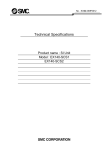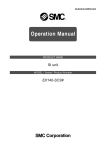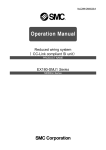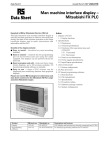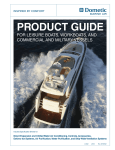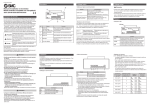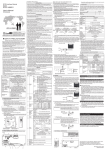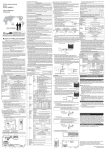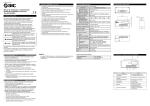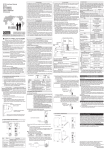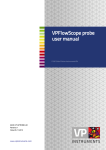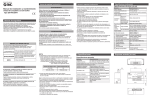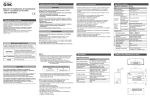Download Reduced wiring system (CC-Link compliant SI unit) EX140
Transcript
文書 No.EX※※-OME0011-B Reduced wiring system (CC-Link compliant SI unit) PRODUCT NAME EX140-SMJ1 Series MODEL/ Series Table of Contents SAFETY 2 Model indication method / How to order 8 Parts and functions description 8 Mounting / Installation 10 Settings 12 Specification 13 Specifications 14 Dimensions 15 Maintenance 16 Maintenance 16 Troubleshooting 17 Troubleshooting 17 List of Troubles and Countermeasures 18 ‑1‑ No.EX※※-OME0011-B SAFETY This manual contains essential information to prevent possible injury and damage to (users and other people, and property) and to ensure correct handling. Please confirm understanding the definition of the following messages (signs) before going on to read the text, and always follow the instructions. Also read carefully the instruction manual of relevant equipment or apparatus before use. ♦Indications IMPORTANT MESSAGES Read this manual and follow its instructions. Signal words such as WARNING, CAUTION and NOTE, will be followed by important safety information that must be carefully reviewed. Indicates a potentially hazardous situation which could result in death or serious injury if you do not follow instructions. Indicates a potentially hazardous situation which if not avoided, may result in minor injury or moderate injury. NOTE Gives you helpful information. ♦Operator ♦This operation manual has been written for those who have knowledge of machinery and apparatus that use pneumatic equipment and have full knowledge of assembly, operation and maintenance of such equipment. ♦Please read this operation manual carefully and understand it before assembling, operating or providing maintenance to the SI Unit. ♦Usage Restrictions ♦This product is designed for use in general equipment for factory automation. Never use this product with equipment or apparatus that directly concerns human lives*1, or which malfunction or failure can cause a huge loss. *1: Equipment or apparatus that directly matters human lives means the following: • Medical equipment such as life support systems or equipment used in operating rooms • Compulsory equipment required by law such as the Fire Prevention Law, Construction Law and etc. • Equipment or apparatus that conforms with those mentioned above. ♦Contact our sales department when plans are made for the product to be used for the system*2 including equipment that concerns itself with the safety of persons or that seriously affects the public. This usage needs special consideration*3. *2: The system including equipment that concerns itself with the safety of persons or that seriously affects the public means the following: • Nuclear reactor control systems in nuclear power plants, safety protection systems or other systems important for safety in nuclear power facilities • Driving control systems of mass transportation systems, and flight control systems • Equipment or apparatus that comes into contact with foods or beverages *3: Special consideration means discussing usage with our engineers to establish a safe system designed as fool-proof, fail-safe, redundant and etc. ♦Special consideration of safety or maintainability should be taken to prevent hazard or loss caused by a failure or malfunction that is likely to occur in certain probability due to environmental stress (deterioration). The special consideration means to fully review the equipment or apparatus in design stage and to establish a backup system in advance such as a redundant system or fail-safe system. -2- No.EX※※-OME0011-B ♦The compatibility of pneumatic equipment is the responsibility of the person who designs the pneumatic system or decides its specifications. Since the products specified here are used in various operating conditions, their compatibility with the specific pneumatic system must be based on specifications or after analysis and / or tests to meet your specific requirements. ♦Only trained personnel should operate pneumatically operated machinery and equipment. Compressed air can be dangerous if an operator is unfamiliar with it. Assembly, handling or repair of pneumatic systems should be performed by trained and experienced operators. ♦Do not service machinery / equipment or attempt to remove components until safety is confirmed. 1.Inspection and maintenance of machinery /equipment should only be performed after confirmation of safe locked-out control positions. 2.When equipment is to be removed, confirm the safety process as mentioned above. Cut the supply pressure for the equipment and exhaust all residual compressed air in the system. 3.Before machinery / equipment is re-started, take measures to prevent quick extensions of the cylinder piston rod etc. (Bleed air info the system gradually to create back-pressure.) ♦Contact SMC if the product is to be used in any of the following conditions: 1.Conditions and environments beyond the given specifications, or if product is used outdoors. 2.Installation on equipment in conjunction with atomic energy, railway, air navigation, vehicles, medical equipment, food and beverage, recreation equipment, emergency stop circuits, press applications, or safety equipment. 3.An application which has the possibility of having negative effects on people, property, or animals, requiring special safety analysis. -3No.EX※※-OME0011-B ♦Do not disassemble, modify (including change of printed circuit board) or repair. It may result in injury or failure. ♦Do not operate the product beyond specification range. Operation at a range that exceeds the specifications can cause a fire, malfunction, or damage to the unit. Verify the specifications before use. ♦Do not use the product in an atmosphere containing combustible, explosive or corrosive gas. It can cause a fire, explosion or corrosion. The unit is not designed as explosion-proof. ♦The following instructions must be kept when using the product in an interlocking circuit: • Provide double interlocking by another system such as mechanical protection • Check the product regularly to ensure proper operation Otherwise malfunction may cause an accident. ♦The following instructions must be kept during maintenance: • Turn off the power supply • Stop the supplied air, exhaust the residual pressure, and confirm the release to atmosphere before performing maintenance Otherwise it may cause injury. ♦Perform proper functional checks after maintenance. Stop operation when an abnormality is observed such that the unit does not work properly. Safety may not be able to secured if unexpected incorrect operation occurs. ♦Provide grounding for securing safety and noise resistance of reduced-wiring system. Provide an individual grounding as possible, and place it near the unit to shorten the distance between the grounding and the unit. -4No.EX※※-OME0011-B NOTE ♦Follow the instructions given below for selecting and handling reduced-wiring system : ♦Selection (Follow the installation, wiring, environment of use, adjustment, operation, and maintenance described below, too.) ∗Product specifications • Use the following UL recognized direct-current power supply for direct power supplies to combine. (1) Limited voltage current circuit in accordance with UL508 A circuit whose power is supplied by secondary coil of a insulating transformer that meets the following conditions • Maximum voltage (with no load) : less than 30Vrms (42.4V peak) • Maximum current : (1) less than 8A(including when short circuited) (2) limited by circuit protector (such as fuse) with the following ratings No load voltage (V peak) Max. current rating (A) 0 ∼ 20 [V] 5.0 Above 20 to 30 [V] 100 / peak voltage (2) A circuit using max. 30Vrms or less (Class-2 circuit), whose power is supplied by Class-2 power supply unit in accordance with UL1310, or Class-2 power supply unit in accordance with UL1585 • The reference of power supply for SI unit is 0V for both powers for solenoid valves and SI unit controlling part. • Operate reduced-wiring system with the specified voltage. Operation with a voltage beyond specifications could cause malfunction or damage of the unit. • Reserve a space for maintenance Keep space for maintenance for the layout of the unit. • Do not remove nameplate. Otherwise maintenance error and misreading of an operation manual could cause damage or malfunction. It may also result in nonconformity to the safety standards. ♦Precautions on handling ∗Installation • Do not drop, hit or apply excessive shock to the unit. Otherwise the unit could be damaged, and cause failure and malfunction. • Follow the specified tightening torque. Excessive tightening torque can break screws. ∗Wiring (including plugging in/out of connector) • Do not bend the cables or apply excessive force to them by pulling or placing heavy load. Wiring subject to bending or tensile stress could cause breakage of a cable. • Connect wires and cables correctly. Incorrect wiring could cause damage or malfunction to the reduced-wiring system. -5No.EX※※-OME0011-B • Do not connect wires while the power is supplied. Otherwise, the reduced-wiring system could be damaged or malfunction. • Do not connect power cable or high-voltage cable in the same wiring route as the unit. Otherwise the wires to the reduced-wiring system can be interrupted with noise or induced surge voltage from power lines or high-voltage lines and malfunction could be caused. Separate wiring of the unit and each I/O device from that of power line and high voltage line. • Verify the insulation of wiring. Insulation failure (interference with other circuit, poor insulation between terminals and etc.) could introduce excessive voltage or current to the reduced-wiring system or each I/O device and damage them. • Separate power line for solenoid valves from power line for input and control unit. Otherwise wires can be interrupted with noise or induced surge voltage causing malfunction. • Take proper measure against noise such as noise filter when the reduced-wiring system is incorporated in equipment or devices. Otherwise contamination with noise can cause malfunction. ∗Environment • Consider using the reduced-wiring system in operating environment suitable for enclosure. In case of IP20, avoid use in the place where water and oil scatter. • Take sufficient shielding measures when the unit is installed. Insufficient measures could cause malfunction or failure. Verify the effect of the measures after incorporation of the unit in equipment or devices: (1) A place where noise due to static electricity is generated (2) A place where electric field strength is high (3) A place where there is radioactive irradiation (4) A place near power line • Do not use the unit near a place where electric surge is generated. Internal circuit elements of the reduced-wiring system can deteriorate or break when equipment generating a large surge (electromagnetic lifter, high frequency induction furnace, motor, etc.) is located near the reduced-wiring system. Provide surge preventives, and avoid interference with line for the equipment. • Use the reduced-wiring system equipped with surge absorber when a surge-generating load such as solenoid valve is driven directly. Direct drive of a load generating surge voltage can damage reduced wiring system. • Prevent foreign matters such as remnant of wires from entering the unit. Take proper measures for the remnant not to enter the reduced-wiring system in order to prevent failure or malfunction. • Do not expose the reduced-wiring system to vibration and impact. Otherwise failure or malfunction could be caused. • Keep the specified ambient temperature range. Otherwise malfunction could be caused. Do not use reduced-wiring system in a place where temperature suddenly changes even within the specified range. • Do not expose the reduced-wiring system to heat radiation from a heat source located nearby. Malfunction could be caused. ∗Adjustment and Operation • Use precision screwdriver with a small flat blade for setting the DIP and rotary switches. ∗Maintenance • Perform maintenance and check regularly. Otherwise an unexpected malfunction of components could of the unit occur due to a malfunction of the whole unit. • Perform a proper functional check. Stop operation when an abnormality is observed such that the device doesn't work properly. Otherwise an unexpected malfunction of the unit component can occur. -6No.EX※※-OME0011-B • Do not use solvents such as benzene, thinner or other to clean the reduced-wiring system. They could damage the surface of the body and erase the indication on the body. Use a soft cloth to remove stains. For heavy stains, use a cloth soaked with diluted neutral detergent and fully squeezed, then wipe up the stains again with a dry cloth. • Do not use solvents such as benzene, thinner or other to clean the reduced-wiring system. They could damage the surface of the body and erase the indication on the body. Use a soft cloth to remove stains. For heavy stains, use a cloth soaked with diluted neutral detergent and fully squeezed, then wipe up the stains again with a dry cloth. -7- No.EX※※-OME0011-B Model indication method / How to order ・SI unit series EX140 Parts and functions description ♦Parts and functions description No. Parts Purpose 1 Communication terminal (DA,DB,DG) To connect the CC-Link line with a CC-Link-dedicated cable. 2 Power supply terminal (24V,0V) To supply power to solenoid valves. 3 Power supply terminal (+24V,24G) To supply power to the SI unit controller. 4 FG terminal Used for functional ground. 5 Display The status of the unit is indicated with LED. 6 Setting switch area The station number and transmission speed are set. ♦Terms definition No. Term Definiton 1 Total of station Total number of occupied stations among all slaves connected by the CC-Link. 2 Station number Numbers from 1 to 64, assigned to the slave stations. No. 0 is assigned to the master CC-Link. Slave stations must be assigned numbers according to the number of occupied stations so they are not duplicated. 3 Slave station General term for any station except the master station. 4 Number of occupied slaves Number of networked stations in use by a slave. Depending on the data, one to four stations can be set. The remote I/O only occupies one station. 5 Remote I/O A station which can only use digital data. Occupies only one station. (Example: digital units, solenoid valves, sensors, etc) -8- No.EX※※-OME0011-B • Settings for display Display Meaning PWR. It lights up when the communication power is ON SD Check whether SI unit is communicating with the master station correctly. It lights up when SI unit is receiving normal data from the master station. It goes out for time-out. It lights up when data is being sent RD It lights up when data is being received L RUN It illuminates during communication errors (CRC errors). It illuminates during a time-out (the L RUN light extinguishes). It illuminates for station no. setting and communication speed setting errors (the light extinguishes when the setting has been corrected L ERR. and power has been restored). It blinks when the station no. and communication speed settings have changed during the communication. (the L RUN light illuminates and the SI unit operates according to the station no. and communication speed settings input when power is applied.) If data link is correct, “PWR.”, “LRUN”, “SD”, and “RD” light up. -9- No.EX※※-OME0011-B Mounting / Installation ♦ Communication wiring The connection between a CC-Link-dedicated cable and an SI unit communication terminal for CC-Link is shown below. (1) Be sure to connect a signal line to its dedicated terminal. (Refer to Fig.1) Tighten it securely with a torque of 0.5 to 0.6 [N・m]. (2) Be sure to connect a terminating resister between “DA” and “DB” at both ends of the CC-Link system (Refer to Fig.2). Use a cable with the same specifications as a CC-Link-dedicated cable. If a cable with any other specifications is used, normal data transmission cannot be guaranteed. (3) The appropriate terminal resistor differs depending on the CC-Link cable used (Refer to the table and Fig. 3 below.) The CC-Link-dedicated cable’s shield line should be connected to the “FG” terminal of the SI unit. Cable type CC-Link detected cable CC-Link dedicated cable compatible to Ver.1.10 CC-Link dedicated high performance cable Terminal resistor 100Ω 1/2W (Brown, Brown, Brown) 130Ω 1/2W (Brown, Orange, Brown) -10- No.EX※※-OME0011-B ♦ Power supply wiring Connect the power wiring to the SI unit’s solenoid valve and communication power supply terminals. Though the power supply consists of two systems, it can operate with either a single or separate power supplies. Be sure to connect the power to the dedicated terminal (Refer to Fig. 4). Tighten it securely with a torque of 0.5 to 0.6 [N・m]. *Note D-type Ground (3rd type ground) for the FG terminal (the SLD and FG terminals in CC-Link are connected within the SI units.) A.For single power supply use B.For dual power supply use -11- No.EX※※-OME0011-B Setting • Switch setting • The setting for station no. and communication speed can be done with rotary switches in SI unit cover. The setting for HOLD/CLEAR can be done with DIP switch in SI unit cover. The setting shall be done when the power for SI unit is turned off. • Station number setting Seting ×10 ×1 Setting range 0〜6 0〜9 * The station no. should be any of the numbers from 01 to 64. When numbers 00 or 65 or more is set, “L ERR” will light up. * The station no. cannot duplicate. It will cause mounting condition error. * The setting at shipment is 00. • Setting of transmitting speed Seting 0 1 2 3 4 Transmitting speed 156kbps 625kbps 2.5kbps 5kbps 10kbps * The setting for communication speed should be in range from 0 to 4. If the setting is out of the range, “L ERR” will light up. After turning the power off, correct the number. * Set the same communication speed as the master station. * The setting at shipment is 0 (156kbps). • HOLD/ CLEAR settiing HOLD/CLEAR Function CLEAR Clear the output when errors occur. HOLD Hold the output when errors occur. * The setting at shipment is CLEAR. -12No.EX※※-OME0011-B Specification ♦Specifications Communication specification Item Specifications Applicable system CC-Link Ver.1.10 Occupied station 1 station Station number setting 1 to 64 (Set with a rotary switch) range Station type Communication speed Remote I/O 156kbps 625kbps 2.5Mbps 5Mbps 10Mbps 900m 400m 160m 100m Cable length between 20cm or more stations Max. cable length 1200m Communication power voltage 15V DC to 30V DC Solenoid valve voltage 24V DC +10%/-5% Output 16 points Current consumption Com./internal power supply: 24V DC/0.1A or less Solenoid valve power supply: 24V DC /1.4A or less Environ. resistance Enclosure IP20 Withstand voltage 500VAC 1min. (Between FG and external terminal) Insulation resistance 2MΩ or more (500VDC between FG and external terminal) Operating temperature: 0o to +55oC (when 8 points are on) Ambient temperature 0 oC to +50 oC (when 16 points are on) Storage: -10 oC to 60 oC Ambient humidity 35% to 85%RH (No due condensation) Vibration resistance 5G (Per JIS C0911 10 to 55Hz Impact resistance 10G (Per JIS C0912) Operation atmosphere No corrosive gas Standard CE marking Weight 80g or less one-way amplitude :0.5mm) (Note 1) Note 1 : EMC directive(89/336/EEC) EN61000-6-2:2001 EN55011:1998+A1:1999+A2:2002 -13- No.EX※※-OME0011-B ♦Electric・Communication Specification Item Power voltage range and power consumption Specification Power voltage and power consumption for SI unit Power voltage and power consumption for solenoid valve Output Connection Solenoid valve load connection Residual spec. voltage Insulating method DC15 to 30V 0.1A or less DC24V+10%,-5%(DC22.8 to 26.4V) Per spec. of solenoid valve numbers 1.4A or less N-ch MOS-FET (Open drain method) DC24V, a solenoid valve with a lamp/surge protection circuit (by SMC) DC0.4V or less Photo coupler Insulating method Station number 1 to 64 (setting with rotary switches) setting range Communication speed setting range Communicatio Applicable n Specification system 156kbps,625kbps,2.5Mbps,5Mbps,10Mbps (setting with rotary switches) CC-Link Ver.1.10 Occupied station 1 station Station type Remote I/O Output 16 points ♦Applicable solenoid valve series Representative series Applicable series SQ series SQ1000,2000 series SZ series SZ3000 series -14- No.EX※※-OME0011-B ♦Dimensions -15- No.EX※※-OME0011-B Maintenance ♦Maintenance •Mounting and wiring Item to inspect Are SI unit terminals (for communication and power supply) securely connected? Criteria Isn’t the connecting cable broken. •Replacement Tighten the connector. (refer to the Technical Specifications for “Mounting/ Installation”) No looseness. Are the terminating resistance securely connected to the both ends of Terminating the network (in case this system is at connected. the end of the network) Countermeasure resistors No apparent breaks Connect suitable terminating are resistors to cables (see “Mounting /Installation” in this operation manual). If any visible breaks are found, replace the cable. parts Item to inspect Criteria Countermeasure If any visible breaks are found, replace the cable. CC-Link dedicated cable No appearance error SI unit If it does not operate as intended, No error in operation and or the display indicates errors, display replace the unit. •Power supply Item to inspect Criteria Countermeasure Measure voltage at both ends of the SI DC15V〜DC30V unit controller's power supply to ensure it is within the specified range. Investigate into the cause of voltage fluctuation, and take a countermeasure against it. Measure voltage of the solenoid valve’s power supply to ensure it is within the specified range. Investigate into the cause of voltage fluctuation, and take a countermeasure against it. DC24V+10%/-5% -16- No.EX※※-OME0011-B Troubleshooting ♦Troubleshoot Applicable model : EX140-SMJ1 If a SI unit gets an operation failure, look for the problem using the following flow chart. If any cause of the problem cannot be found, and a new SI unit can operate well after replaced with the old one, the failure of SI unit is conceivable. As the failure of SI unit may happen due to the operation environment (network construction etc), consult us about the countermeasure against that case. If neither cause of the problem nor failure of SI unit can be found, inconsistency between parameter setting and the network construction at the master station is conceivable. In this case, refer to “Troubleshooting” in a user’s manual (CC-Link system) by Mitsubishi. Solenoid valve’s malfunction. Yes No Only the LED at a solenoid valve is lit up. Solenoid valve’s failure PWR.LED at SI unit goes off. See Trouble No. 1 RD_LED at SI unit goes off. See Trouble No. 2 L RUN_LED at SI unit goes off. L ERR.LED at SI unit goes off. See Trouble No. 3 See Trouble No. 4 SD_LED at SI unit goes off. See Trouble No. 5 L ERR.LED at SI unit flashes. See Trouble No. 6 Solenoid valve’s malfunction. See Trouble No. 7 SI unit has no error. -17- No.EX※※-OME0011-B ♦List of Troubles and Countermeasures Trouble No. Problem Possible cause Investigation method Countermeasure Check the SI unit controller SI unit controller’s power supply wiring failure. 1 PWR.LED at SI unit goes off. SI unit controller’s power supply failure. power supply cables for breaks. Also check the terminal between the power supply cable and Connect the power connector for looseness. supply cable correctly. Avoid repetitive bending and pulling of the cable, which causes breakage. Check the SI unit controller’s power supply wiring for any error. Correct the wiring. Check the SI unit controller’s power supply for supply voltage. Supply 24VDC +10%/-5% to SI unit controller’s power supply. Check the communication line cable for breaks. Also check the terminal between the communication cable and the connector for looseness. 2 PWR.LED at SI Communication unit is lit up. Avoid repetitive bending and RD_LED at SI unit line wiring pulling of the cable, which failure. goes off. causes breakage. Check the communication line wiring for any error. Connect the power supply cable correctly. Correct the wiring. -18- No.EX※※-OME0011-B Trouble No. Problem Possible cause Investigation method Master station’s Check the power is supplied to power supply the master station. failure. 3 4 Check the existence of equipment and high voltage line, Communication which cause noise, around the failure. L RUN_LED at SI communication and power unit goes off. supply lines. L ERR.LED at SI Ensure there is no difference unit goes off. Station number betwen the SI unit station setting failure. number setting and the station data at the master station. L RUN_LED at SI unit goes off. L ERR.LED at SI unit is lit up. Ensure there is no difference Communication between the SI unit and master speed setting station communication speed failure. settings. Station number setting failure. Ensure there are no errors or Station number duplications of the station duplicating numbers. failure. Communication Ensure the communication speed setting speed is set correctly. failure. Countermeasure Check the power is supplied to the master station. Separate the communication and power supply cables from the noise sources. Correct the setting. Correct the setting. To review the setting method, see “Settings”. -19- No.EX※※-OME0011-B Trouble No. 5 Problem Possible cause Check there is no difference Communication between the set communication speed setting speed at SI unit and the set L RUN_LED at SI failure. communication speed at the unit is lit up. master station. SD_LED at SI unit Station number setting failure. goes off. Check that the set station Station number numbers contain no errors or duplicating duplication. failure. Failure in Check that the communication changing communication speed setting has not changed after supplying power to the SI unit controller. speed 6 Investigation method L RUN_LED at SI unit is lit up. L ERR.LED at SI unit flashes. Changed station number setting. Check that the station number setting has not changed after supplying power to the SI unit controller. Check the existence of equipment and high voltage line, Communication which cause noise, around the failure. communication and power supply lines. Countermeasure Correct the setting. Cut the SI unit controller's power supply, and supply the power again after correcting the setting. Separate the communication and power supply cables from the noise sources. -20No.EX※※-OME0011-B Trouble No. 7 Problem Solenoid valve malfunction. Possible cause Investigation method Countermeasure Solenoid valve failure. Check the operation with another solenoid valve, or check the troubleshooting for a solenoid valve. Check the troubleshooting for a solenoid valve, or consult our responsible division. Connection failure between SI unit and manifold solenoid valves. Check the connector between SI unit and manifold solenoid valves for the connection failure such as a bent pin Correct the connection between SI unit and manifold solenoid valves. Solenoid valves whose Check the total output points of total output the solenoid valves connected to points are 16 or a manifold are 16 or less. more malfunction. As EX140-SMJ1, max. output points are 16, the output points must be 16 or less. -21- No.EX※※-OME0011-B Revision history B:new format URL http://www.smcworld.com Phone AUSTRIA / (43) 2262-62 280 BELGIUM / (32) 3-355 1464 CZECH REP. / (420) 5-414 24611 DENMARK / (45) 70 25 29 00 FINLAND / (358) 9-859 580 FRANCE / (33) 1-64 76 1000 GERMANY / (49) 6103 4020 GREECE / (30) 1- 342 6076 HUNGARY / (36) 1-371 1343 IRELAND / (353) 1-403 9000 ITALY / (39) 02-92711 NETHERLANDS / (31) 20-531 8888 NORWAY / (47) 67 12 90 20 POLAND / (48) 22-548 50 85 PORTUGAL / (351) 2 610 89 22 SPAIN / (34) 945-18 4100 SWEDEN / (46) 8-603 0700 SWITZERLAND / (41) 52-396 3131 TURKEY / (90) 212 221 1512 UNITED KINGDOM / (44) 1908-56 3888 Note : Specifications are subject to change without prior notice and any obligation on the part of the manufacturer. The descriptions of products shown in this document may be used by the other companies as their trademarks. © 2005 SMC Corporation All Rights Reserved No.EX※※-OME0011-B

























